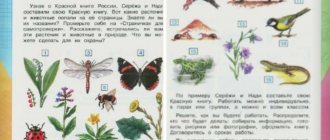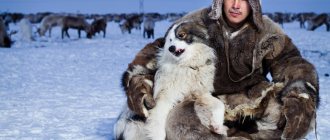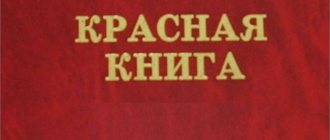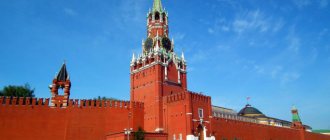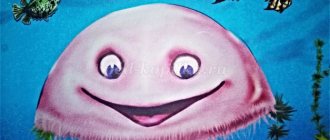Red Book of Animals of Russia - what is it?
Getting acquainted with the animals of the Red Book should begin in childhood. Children of primary school age will understand from a very young age that the destruction of animals should not be allowed. Children should be explained that the animal world should be protected, and that endangered rare species should be treated especially carefully.
This article is a tip for parents, teachers, and older children who want to find out for themselves and tell their children about the Red Book, to get acquainted with rare species of various animals listed in the Red Book. Brief descriptions and photographs of rare animals are presented here.
There are a huge number of animals in the world. But, unfortunately, many of them are at the stage of extinction. Populations of some animal species are gradually disappearing from the face of the globe; many species have already become extinct.
The reason for the decline in animal populations is primarily human activity. Most often, people can unknowingly harm not only animals, but also plants. This occurs as a result of environmental pollution by atmospheric toxic substances, deforestation, during the development of new lands and other anthropogenic actions. But, unfortunately, some people deliberately destroy animals. Such people are called poachers. For the sake of valuable fur, meat, and tusks, poachers destroy animals all over the world. The problem of poaching is very serious in many countries around the world.
The following animals no longer exist in nature:
- Tarpan horse
- Turanian tiger
- Sea cow
- Tour
Now these species can only be found on the pages of encyclopedias. But once they existed in our nature, they were a numerous part of the fauna.
Important: the Red Book was created . The book is called this because the color red symbolizes danger and anxiety. The book exists to draw the attention of all people to the existing problem of extinction of animal and plant species. The Red Book includes not only animals, but also rare species of plants and fungi. Our country also has a Red Book of Animals.
The pages of the Red Book have their own colors, which indicate:
- Black - the animals listed on these pages are already extinct.
- Red - indicates animals on the verge of extinction.
- Yellow - rare species of animals that are not yet extinct.
- Green—restored populations.
- White - species of animals that are in doubt of extinction.
The Red Book of the USSR first appeared in 1978. Since then, the book has been supplemented many times with new names of animals. The Red Book and the animals listed in it are protected by law. The Red Book is a state document.
There are regional books, in them you can see rare animals of a certain region. A lot of work is being done to identify rare and endangered species of animals. Some species are called into question, and the Red Book also makes it possible to preserve the number of rare animals and revive their population. For example, thanks to human protection and care, it was possible to restore such animal species as elk, river beaver, stag beetle, and belladonna.
Top 10 plants of the Red Data Book of the Russian Federation
The Red Book consists of several volumes. The second is entirely devoted to flora and includes plants that are also on the verge of complete extinction from the face of the Earth.
The list of the rarest representatives of the plant world includes:
Nut lotus
A plant that is the only representative of the lotus genus. On the territory of the Russian Federation, it is widespread in the Volga delta; it can also be found in the Far East and Transcaucasia.
This plant belongs to the relict species and has been preserved only due to the fact that people actively cultivated it. The Caspian variety is widespread in Russia, which differs from others in the pinkish color of the flower, which is smaller in size compared to Asian lotuses. Also, the Caspian lotus is adapted to low temperatures.
The extermination of the plant occurs because of its beauty. But it should be remembered that outside the water, the lotus very quickly loses its attractiveness.
Nut lotus
Lily lanceolifolia
A plant that is familiar to many gardeners, as it has been actively cultivated for several centuries.
On the territory of the Russian Federation in the wild, the plant is found exclusively on the rocky slopes of the Primorsky Territory in the Khasansky district . The number of flowers in nature is no more than 500 copies.
The reason for the rapid destruction of plants is the development of the territory on which the flower grows by man for his own needs. Also one of the reasons is the short-sightedness of a person who digs up bulbs for cultivation, not realizing that a wild plant will not take root in the garden.
Lily lanceolifolia
Saffron is wonderful
An endangered plant that can be found on the territory of the Russian Federation in the Stavropol and Krasnodar territories, the republics of Dagestan, Adygea and the southern coasts of Crimea.
The plant is adapted to living in dark places, so very often it can be found surrounded by perennial shrubs.
The reasons for the disappearance of plants in their usual places of growth are plowing of land and construction . The quantity is also reduced by people themselves, who dig up bulbs to grow in gardens or simply pick flowers for a moment's pleasure.
To preserve the population, the plant is cultivated in 14 botanical gardens in Russia. This makes it possible to develop new varieties that are distinguished by good reproduction and resistance to negative external factors.
Saffron is wonderful
Dwarf tulip
It is not for nothing that this plant is called dwarf, since its height does not exceed 10 cm. The flower grows at an altitude of 2400 to 3000 meters above sea level. It can often be found in the Alpine belt.
In Russia, the plant is found wild only in the Caucasus . This flower is very well suited for artificial cultivation. It can be found in flower beds, lawns or simply as a potted plant.
Dwarf tulip
Snowdrop flatifolia
The distribution areas of this first spring flower are the Caucasus and Crimea. The largest population is found on the mountainous slopes of the Caucasus.
There is a beautiful legend according to which, after Eve was expelled from paradise, it began to snow. She walked and cried. In the place where the tear fell, a thawed patch appeared, and a snowdrop sprouted, as a symbol of hope for forgiveness. Yandex
According to the Red Book categorization, this plant has status 3 , which means a rare species on the verge of extinction.
The beauty and tenderness of this flower led to its cultivation. Since the plant is under protection, only those flowers that have been grown artificially are allowed for sale.
Snowdrop flatifolia
Volodushka Martyanova
An inconspicuous plant, which is also listed in the Red Book. On the territory of the Russian Federation, its habitats are the Krasnoyarsk Territory, Altai, and floodplain parts of the Yenisei.
The plant is medicinal. It lives in soils that have sufficient moisture, without excess moisture. Often the flower can be found on protruding rocks and stone placers.
The number of this species is influenced by the inability to grow in dry climates, low competitiveness, and lack of cultivation ability.
Volodushka Martyanova
Rhododendron Schlippenbach
The plant got its name from the name of the sea traveler who became its savior when the flower was on the verge of complete extinction in Korea.
This species is the only deciduous rhododendron. Endemically, the plant originates from the Far East.
This species has a long lifespan. In nature, there are specimens whose age reaches 50 years , which is a lot for a deciduous crop.
Despite the presence of the plant in the Red Book, it has a large population. This is explained by the fact that this species reproduces well and easily takes root when transplanted. The only prohibition is imposed on the replanting period - this is the time of flowering or late autumn.
Rhododendron Schlippenbach
Ginseng
A plant that belongs to the medicinal group, which is included even in its name. It translates as "panacea". The most valuable part is considered to be the root, which is used to treat many ailments and restore youth.
The original habitats of ginseng in the Russian Federation are the Far East, Khabarovsk and Primorsky Territories.
Ginseng
Bell dolomite
A plant that grows exclusively in the Russian Federation. Its natural habitat is Kabardino-Balkaria, Ingushetia, Ossetia, Dagestan and the Chechen Republic.
The number of this beautiful flower, which has large, snow-white buds reaching sizes up to 4 cm , is declining due to land cultivation, road construction, and also simply from people’s desire to get momentary pleasure by picking blooming bells.
Bell dolomite
Spotted palmate root
A species that belongs to the orchid family. On the territory of the Russian Federation it can be found in the wild in shaded areas of forests in the European part. The species is on the verge of extinction and is extremely difficult to find in nature.
One of the reasons for the destruction of the plant is its medicinal properties . It is believed that dried tubers of the plant are able to eliminate inflammatory processes and have a general strengthening effect.
Also, often a flower is picked by people who do not think about the fact that they are destroying a rare plant, but only think about a beautiful bouquet.
Spotted palmate root
Mammals of the Red Book of Russia: names, photos, descriptions
The list of endangered animal species is very long. We will list the most famous of them.
Amur tiger
One of the largest representatives of the cat family. In size it is second only to the Bengal tiger. The Amur or Ussuri tiger lives in the Russian Far East. The tiger is adapted to survive in cold conditions thanks to a thick layer of fat. Amur tigers live alone. Sometimes females can be found in a group. The weight of the animal can reach 250 kg. This species requires a huge territory in which it will be the owner (0.5-1 km). In the wild, a tiger lives 15 years; in captivity, it lives up to 20 years.
Amur tiger
Polar bear
A large predator that lives near the Bering and Chukchi Seas. The Chukotka range of polar bears is considered the largest in the world. High mortality among young animals is common among polar bears. 10-30% of cubs die, and bears reproduce slowly. This makes the species look vulnerable. The body weight of a male can reach 450 kg, and cubs are born weighing 700 grams. The polar bear is considered a symbol of the Arctic.
Polar bear
Red Wolf
A rare species of canid. The red wolf differs in many ways from its cousins, the gray wolves. It can be confused with a fox; it is distinguished by a reddish tint of its skin and a fluffy tail. Scientists put forward the opinion that it was not man who caused the extinction of this species, but nature. It is believed that gray wolves are to blame for the disappearance of their brothers, with whom red wolves cannot compete in strength.
Red Wolf
Bison
This huge representative of artiodactyls lives on average 23-25 years. Basically, bison live in nurseries. This is how their population is preserved. They are also released into the wild. Bison live in small herds consisting of females and calves. Bulls live alone. The bison, as a rule, does not attack humans and behaves calmly.
Bison
Altai mountain sheep
Lives in the mountainous regions of Altai, Eastern Siberia. Due to the fact that the species lives in hard-to-reach places, it is difficult to track its numbers. Mountain sheep are often attacked by wolves and other predators, which reduces their numbers. It is famous for its luxurious horns, which makes it a tasty prey for hunters.
Altai mountain sheep
Snow Leopard
Another name is snow leopard. A small part of the total number of snow leopards lives in Russia (10-20%). Habitat in Russia - Buryatia, Krasnoyarsk Territory, Altai, Khakassia. The snow leopard is a lithe big cat with a beautiful smoky gray coat and ringed spots. The snow leopard lives in the wild for about 13 years; in captivity, its lifespan increases to 21 years.
Irbis
bottlenose dolphin
Bottlenose dolphins are very friendly dolphins. They do not attack humans; on the contrary, they show interest. There are known cases when schools of bottlenose dolphins surrounded people in a ring, protecting them from sharks. There are also cases of bottlenose dolphins rescuing drowning surfers. These are very smart animals. It has been proven that in captivity they are often exposed to stress, which affects their life expectancy.
Dolphin
Caucasian European mink
It is a subspecies of the European mink. It lives in the Caucasus in small rivers and streams. For a long time, mink were destroyed in order to obtain valuable fur.
Caucasian mink
Black book
As for the extinct species of animals, plants, fungi and microorganisms, it is now very difficult to find anything more detailed about them than a meager description and a few pictures, because the book takes into account individuals and specimens over the past 100 years. Speaking of animals, the book lists about 30 species and subspecies. There you can find such extinct species as:
- Tur, popularly called the “primitive bull”.
- Steller's cormorant.
- Steller's cow.
- Caucasian bison.
- Rodriguez's parrot.
- Falkland fox.
The book contains a fairly large list, but it is almost impossible to describe the animal with accuracy and talk about any of its features.
I would like to note that there is also a so-called Black Book, although there is no official approval of it. On its pages, records are kept of all the disappeared animals and plants since the distant 1500. There is indeed a very large number of species and individuals listed there. Research claims that until 2000, about 844 animal species and almost 1 thousand plants were introduced into it. They were recorded using stories and notes from travelers, which confirm the existence of these species.
It is important to remember that it largely depends on people whether it will be possible to preserve endangered animal species in Russia. Dense forests, white tundra, various green spaces, gray and yellow steppes, the entire surrounding world - all these are habitats for thousands of species of animals, birds and plants, so it is necessary to prevent their destruction and pollution of territories.
This topic is often discussed in the government, but one thing is clear: even a child must firmly grasp the simple truth that nature must be protected.
Birds of the Red Book of Russia: names, photos, description
Important: There are a lot of birds in need of protection. Birds often become prey to predators and die. In addition, birds are dying out due to habitat pollution, deforestation, and drainage of swamps.
Below are several representatives of birds from the numerous list of endangered species. It’s worth knowing them in order to protect them and help you survive.
Red kite
The kite is a bird of prey of the hawk family. This is a medium sized bird. It reaches a length of about 70 cm. Having seen the prey, the kite flies down like a stone and grabs it with its sharp claws. On the territory of Russia it lives within the Kaliningrad and Pskov regions, as well as in the Caucasus. The reason for the extinction of kites is human hunting of these birds. Kites often prey on poultry, which causes people to have a negative attitude towards the species.
Red kite
Black stork
A bird of the Stork family with a characteristic black color. This bird avoids people and hides, so it is difficult to observe the life of a black stork.
Black stork
Mandarin duck
A small wood duck with bright colors. On the territory of Russia, the mandarin duck lives on Sakhalin, the Amur Region, and the Khabarovsk Territory. More often the mandarin duck can be found in nature reserves and zoos. In the wild, the mandarin duck builds nests in hollows near water and lives near bodies of water. She rarely dives, only if she is wounded. Chicks are very sensitive to cold and often die. This bird often becomes prey for raccoon dogs and people, which has greatly affected the population of the species.
Mandarin duck
Steppe and stone eagle
These two species are listed in the Red Book of Russia as endangered species. This large bird of the hawk family builds nests on the ground, in small bushes, and in rocks. Rarely builds a nest in a tree. It feeds on rodents, small birds, and carrion. Eagles, especially young ones, are dying out as a result of electric shock on power lines.
steppe eagle
Owl
A large predator from the owl family. The eagle owl is adapted to life in various areas, but most often settles away from humans. It feeds on mice, hedgehogs, small amphibians and birds. The eagle owl has a unique voice that changes depending on the situation. Eagle owls often die as a result of electric shock on power lines.
Owl
mountain goose
A migratory bird famous for its record high flight. A case of bar-headed geese flying at an altitude of 10 thousand meters was recorded. The bar-headed goose is an endangered species. There are about 1,500 individuals in total in Russia, most of them in Altai and a small part in Tuva.
mountain goose
Ptarmigan
Lives in tundra, taiga, forests. The white partridge changes its color depending on the season. In winter it is white, in summer it is brown. Leads a terrestrial lifestyle and takes off on rare occasions. When a severe winter begins in the habitat of the white partridge, it flies to warmer places.
Ptarmigan
Amphibians of the Red Book of Russia: names, photos, description
Amphibians are similar to reptiles and fish. This is a class of primitive vertebrate four-legged animals. The number of amphibians is decreasing due to human pollution of their habitat. Meanwhile, amphibians play an important role in nature. They eat insects that can harm both crops and be carriers of various diseases.
The following species of amphibians are listed in the Red Book of Russia:
Reed toad
It has a color ranging from sand to gray-olive. The body length is about 8 cm. The species can be recognized by the yellowish stripe located along the back. The skin of the reed toad is covered with tubercles. On the territory of Russia, only one habitat is known - the Kaliningrad region. The lifespan of this species is about 15 years. The toad lives in lowlands and loves well-warmed areas by the sun, bordering on humid places.
Reed toad
Caucasian toad
The largest representative of amphibians living in Russia. Body length is about 12.5 cm. The color of small frogs is orange, adult frogs are brown or grayish. The Caucasian toad lives in tree hollows and soil voids. A threat to the population of Caucasian toads is the striped raccoon, which feeds on this species.
Caucasian toad
Ussuri newt
A large tailed newt measuring about 9 cm. Lives in cold streams with a water temperature no higher than 12*C. A necessary condition for the life of the Ussuri newt is the presence of stones or pebbles on the shore, as well as high humidity of the shores. When in danger, the newt buries itself in stones. The Ussuri newt does not have lungs; it breathes through its skin, so it cannot tolerate dry skin.
Ussuri newt
Triton Karelina
Of the genus of newts, Karelin's newt is the largest. Some individuals can reach 18 cm in length. Habitat is the Crimean Peninsula. The skin of the Karelin newt is rough and has a coarse grain. Color: gray, brown with dark spots. The abdomen is yellow or orange. During the mating season, males develop a crest. Males live 8 years, females - 11 years.
Triton Karelina
Common newt
Males and females can only be distinguished during the mating season. The male develops a crest and becomes larger in size than the female. The common newt has a distinctive feature - a longitudinal dark stripe passing through the eyes. In captivity, the common newt can live up to 20 years. In the natural environment, the number of newts is declining due to pollution of water bodies. It is known that in its natural habitat the newt lives no longer than 6 years. Syrian spadefoot. An amphibian similar to a frog, but separated into a separate genus - spadefoot. The Syrian spadefoot has large, bulging eyes with vertical pupils. In Russia it lives in the delta of the Samur River.
Common newt
New version of the book
After the collapse of the USSR and the emergence of Russia as a separate and independent state, the Ministry of Ecology was urgently created. He was tasked with creating a book of rare wildlife species located on the territory of the Russian Federation. For the first time, people saw the Red Book, which reported on rare animals living throughout the state, in 2001 . That’s how long it took to collect all the information on wildlife. There is also an international version of the book.
In total, the following were entered into the book of the Russian Federation:
- 8 large species of amphibians located on the territory of the country or related to their presence in the vast expanses of Russia;
- 21 species of amphibians;
- 128 vertebrate fish;
- about 74 mammals.
After distributing all individuals into classes, the book contained 231 groups of living organisms.
The division into extinction threat categories was constructed as follows:
- The species are under threat of complete extinction. The number has reached critical levels. This subtype indicates that the species listed in the category may become extinct in the near future.
- The number of individuals is rapidly declining. The rate of decline of species is so fast that they will soon belong to the first subtype.
- Marked "rare". The species' territory is limited. They are small in number and have special control over them.
- The status of the individuals is not determined. For these species, for one reason or another, there is no data sufficient to determine the category. In this regard, special control measures have been established over them before assigning them to any category. If a species does not fall under at least one of the classifications, it will remain under this item.
- The numbers are recovering. Naturally or with the use of certain measures, animals begin to restore their population. If the limit is exceeded, they will be removed from the Red Book.
There was also a subtype marked "0". This meant that this species most likely disappeared completely. This includes known invertebrates that have been extinct for hundreds of years due to various factors, and vertebrates that have been known to go extinct for more than 50 years.
Insects of the Red Book of Russia: names, photos, description
In Russia, insects were not included in the Red Book immediately after the book was published. Only 6 years later, namely in 1984, a list of insects in need of protection was published. After the October Revolution, agriculture actively developed, but insect protection remained stagnant. This led to significant destruction of biotopes.
Currently, the Red Book of Russia includes about 100 species of insects.
These include:
Smooth bronze
A beetle measuring about 3 cm with a beautiful shiny green tint. Sometimes the color is copper-red. It lives on old trees; the larvae appear in the hollows of rotten trees. You can find bronze on overripe fruits on trees.
Smooth bronze
Stag beetle
The beetle got its name due to the peculiar structure of the upper jaws, similar to horns. Lives in deciduous forests. The decline in the population of this species is due to massive deforestation, as well as the destruction of the species by collectors. Often beetles are not destroyed on purpose.
Stag beetle
Krasotel fragrant
A species from the genus of ground beetles. Unlike many ground beetles, the fragrant beetle flies well and moves deftly along the branches and trunk of a tree. This beetle feeds on caterpillars and pupae. In case of danger, it releases a substance with a strong odor. You can recognize this beetle by its color: its head has a blue tint, and its wing covers are blue-green with a golden tint.
Krasotel fragrant
Golubyanka Filipeva
A species of butterfly whose numbers have reached a critically low level. There are about 6 known habitats of Filipiev's blueberry. In Russia it can be found in the south of Primorsky Krai in low bushes along river banks. The color of the upper wings is violet-blue, the lower ones are grayish with black splashes.
Golubyanka Filipeva
Wax bee
A species of social bees with a very small habitat in Russia. Lives in hollows of old trees. The number of wax bees is rapidly declining. There is information that there are about 60 families of wax bees in total. Another name is Chinese wax bee.
Chinese wax bee
Woodcutter
A massive beetle with large mustaches. Dimensions: females can reach a body length of 6 cm, and males 4 cm. The largest representative of the genus of woodcutter beetles is the relict woodcutter. The size of males can reach 10 cm. The color is rich brown. In Russia, such beetles can be found on the Black Sea coast, as well as in the Caucasus.
Woodcutter beetle
Reptiles of the Red Book of Russia: names, photos, description
Among reptiles there are also species that are protected and cannot be destroyed. These types include:
Far Eastern turtle
This type of turtle belongs to the soft-bodied turtles. In Asia, the Far Eastern tortoise is a common sight. The meat of this turtle is known to be eaten. However, on the territory of Russia the species is listed in the Red Book; such a turtle can be found on the territory of our country in small habitats in the south of the Far East.
Far Eastern turtle
Gray gecko
A very small lizard no more than 5 cm. In other countries, the gray gecko is not a rare species. In Russia, the gray gecko is considered to be on the verge of extinction or a completely extinct species. The last location of the gray gecko on the territory of the Chechen Republic. The gray gecko loves to live in dry desert areas, desert or semi-desert areas.
Gray gecko
Medium lizard
The largest of the genus of green lizards. The body length can reach 17 cm, and the tail length - 25 cm. Young lizards are brown in color, and adults are rich green with black spots. On the territory of Russia, the average lizard lives in two places: Dagestan and Krasnodar region.
Medium lizard
Poloz
A snake from the genus Colubrida. Several species of snakes are included in the Red Book of Russia: Transcaucasian, Aesculapian, Japanese, striped, thin-tailed. Some species in Russia can be found extremely rarely. For example, the Japanese snake lives only on the Kuril Islands. The Transcaucasian snake lives in the Caucasus. The number of snakes is declining due to the destruction of nests and the destruction of snakes.
Aesculapian snake
cat snake
The species belongs to the Colubridae family. The snake's pupils are vertical, the head is separated from the body by an interception. Color: gray, maybe pinkish. Body flattened laterally. Lives in the territory of Dagestan. Loves slopes with sparse vegetation. Good at climbing trees and walls. In the hot season, the activity of the cat snake begins at night.
cat snake
Gyurza
One of the most dangerous snakes for humans and animals. The viper is the largest representative of the viper family. Its length can reach 2 m. Moreover, in a dangerous situation, the viper can make lunges equal to the length of its body. Even experienced snake catchers fell prey to the viper. The snake can live in various biotopes, but is most often found near springs, rivers and reservoirs.
Gyurza
Caucasian viper
The venom of the Caucasian viper is deadly to humans. The snake is characterized by a bright color, often black, as well as red and orange. Juveniles are brown. Males are smaller in size than females. The snake lives in deciduous forests, lives in vineyards and gardens.
Caucasian viper
Squeaky gecko
This is a very small lizard measuring no more than 4 cm. The color of the gecko is pale yellow with a grayish coating. The belly is white with lemon. In Russia, you can often find the squeaky gecko in the vastness of the Astrakhan region. Lives in desert areas.
Squeaky gecko
Animals are protected all over the world
The protection of flora and fauna is carried out not only in Russia, but also at the international level, since the problems in all countries are identical. Almost everywhere animals, fish and birds are destroyed by humans.
African lion
Despite the fact that the lion is considered the king of beasts, it also needs protection. The problem is mainly due to the fact that more and more wild areas are being inhabited by people, displacing the animal world beyond its borders. Along with the reduction in natural food sources, the number of lions is also decreasing.
Lemur Lory
Lemurs represent a large family of primates. As a rule, they live in trees and are the closest relatives of galagidae, while forming the suborder of the same name, Lorisiformes.
Blue Macaw
This is a bright representative of the parrot family, which is also the only species of the Blue Macaw from the order Psittacidae.
Bengal tiger
This subspecies of tiger belongs to the order of carnivores, the cat family and the genus Panthera. Bengal tigers represent the national animals of historical Bengal or modern Bangladesh, including China and India. Currently listed in the Red Book.
Leatherback turtle
This turtle is also called “lut” and is represented on almost all government papers of the maritime department of the country of Fiji. Residents of the archipelago respect the turtle and consider it the personification of speed and excellent navigation skills.
Brown bear
The brown bear is also called the common bear. Quite a dangerous predator that doesn’t mind eating berries or other sweets. It grows in height to almost 3 meters, climbs trees well and steals honey from bees. He also loves fish.
Steppe Harrier
This bird of prey belongs to the family Accipitridae and the order Accipitridae. The steppe harrier is capable of migrating over considerable distances. Nowadays it has the status of a vulnerable species, therefore it is listed in the Red Book.
Green turtle
Considered to be the largest sea turtle. It is quite interesting to observe them in the natural environment, especially when they feed, moving in dense marine thickets of aquatic vegetation or simply moving in the water column.
Curlew bird
These are quite interesting and bright representatives of birds that belong to the Snipe family and the Charadriiformes order.
Antelope gazelle
Represents a graceful creature of not large size. In its appearance, it meets many people’s ideas about gazelles.
spotted hyena
Belongs to the hyena family and is a predatory animal. It is considered the most numerous representative of this species. They occupy a serious place in the ecosystem, since they are considered the orderlies of the African continent. They can be recognized by the unique sound they make. This sound is similar to a person laughing.
Bird puffin
It prefers to settle on the shores of the Atlantic and until 2015 was a species that was not endangered. It took only 3 years for this unique bird to be included in the IUCN Red Book and declared a vulnerable species.
Lion marmosets
Among the family of primates, small monkeys called lion marmosets are of particular interest. Their fur is so shiny that it seems as if the monkeys were sprinkled with gold dust. Unfortunately, they are on the list of species that may become extinct once and for all.
Olive turtle
This turtle is not large in size, which is listed in the Red Book as a species that is in danger of extinction. A turtle may disappear as a result of human hunting, as well as as a result of other negative factors, such as environmental pollution, etc.
Maned wolf
The maned wolf lives in South America and is considered a very unique animal. It has features of both a wolf and a fox, so scientists classify it as a relict representative of the animal world. Locals call the wolf "guara". Its distinctive features are an elegant, athletic body, not typical for a wolf, with long legs, a sharp muzzle and relatively large ears.
Brownie shark
Due to its unique appearance, the shark was called the goblin shark. Unfortunately, scientists know little about this shark, so no one can say exactly how many, at least approximately, individuals inhabit the world’s oceans. Therefore, it was decided to list the shark in the Red Book as a poorly studied and rare species.
Spectacled bear
The spectacled bear is known as the Andean bear. It is considered a fairly rare predator these days. The animal belongs to the bear family and represents the genus Spectacled Bears.
The rarest animals of the Red Book of the World: list, names, description
Important: The problem of declining animal numbers is observed all over the world. Despite hunting bans and special attention to certain species of animals, the numbers of some species continue to approach zero. Below is a list of the rarest animals in the world that risk ending up in the near future only on the pages of encyclopedias and photographs.
The rarest animals in the world:
- Florida cougar . At last count, there are 230 individuals of this species in the natural environment. The Florida cougar lives in southern Florida in a nature reserve. The only enemy of the Florida cougar is the large alligator. Several factors led to the extinction of the species: scarce genetic material, which resulted in crossing with closely related animals, sport hunting and drainage of the swamps in which this animal likes to live.
- Hirola . This is a rare species of antelope in Africa. The number of hirolas is negligible; there are doubts about whether hirolas still exist, or whether the species is completely extinct. Hirols have long uneven horns, a long face, and a long body. They feed on grass vegetation. When the grass runs out, they migrate to another place. They go without water for a long time due to decreased activity. They are most active in the morning and evening.
- Sumatran rhinoceros . The smallest representative of rhinoceroses. There are several populations; keeping records of Sumatran rhinoceroses and monitoring their lives is difficult due to the animal’s solitary lifestyle. The Sumatran rhinoceros leads a solitary lifestyle, with the exception of the period of birth and nursing the baby. The habits and lifestyle of the animal have not been sufficiently studied, which makes it difficult to keep this species in captivity.
The list of animals is quite long. But this is only a small part of the animals that are on the verge of extinction. Some animals disappear due to natural disasters, but most of them are due to human cruelty and too active human activity. Animals are our little brothers, we must take care of them.
A few more words about the Red Book
In addition to the main volumes, the Red Book has three appendices that do not have the status of a document and have no legal force.
This includes:
- lists of animals and plants that were excluded from the Red Book of the RSFSR;
- a list of species that lived on the territory of the Russian Federation, but have disappeared to date;
- a list of representatives of flora and fauna that, if not on the verge of complete extinction, then at least need special attention to preserve their population in their natural habitat.
It should also be noted that the IUCN Red Book has priority rights for animal protection over national documents of a similar nature.
VIDEO: 10 rarest animals from the Red Book of Russia
10 rarest animals from the Red Book of Russia
Animals and plants of the Red Book of Russia: species, birds, TOP-20 names of animals and plants with descriptions + 100 PHOTOS
